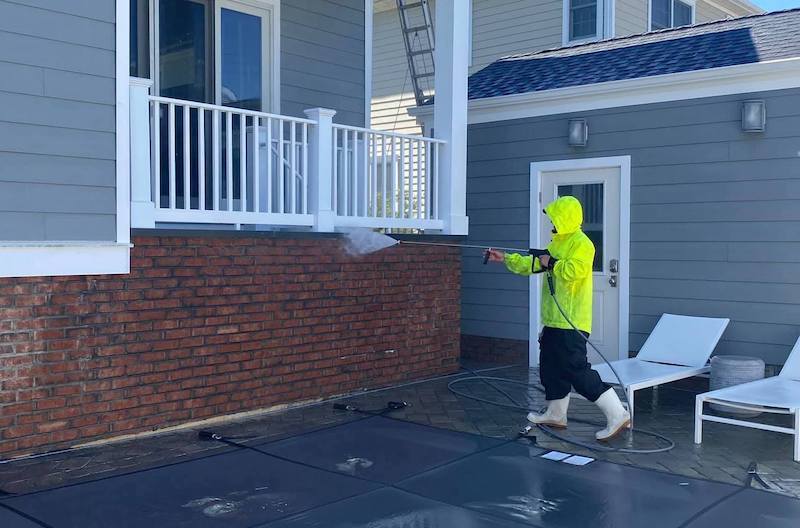
When you’re managing a rental property — whether it’s a single home or a complex of units — keeping things clean and presentable isn’t just about looking good. It’s about protecting your investment, attracting quality tenants, and retaining long-term residents. One of the most overlooked ways to do this? 🧼 Power washing.
From grimy sidewalks and stained siding to mildewed patios and weather-worn fences, rental properties take a beating. Regular power washing helps reverse the wear and tear, boost curb appeal, and make a positive impression on prospective renters.
Here’s how landlords and property managers can use power washing to maximize property value and reduce headaches. 🏠💪
💡 Why Power Washing Matters for Rental Properties
Think of power washing as more than a chore — it’s a maintenance investment.
Benefits include:
- Improved first impressions for showings and listings
- Higher perceived property value
- Longer-lasting exterior surfaces (paint, siding, decks)
- Healthier environment (removes mold, mildew, allergens)
- Reduced complaints from tenants about unsightly messes
- Lower chances of pest infestations that thrive in grime
A clean exterior makes tenants feel proud of where they live — and that pride translates into better care of your property overall. 🧽✨
🧱 What Should You Power Wash?
You don’t have to clean every inch of every surface, but these are common areas where power washing makes a major impact:
1. Siding and Exterior Walls
Over time, dust, algae, and pollution collect on siding. Power washing restores brightness and prevents long-term wear.
2. Driveways and Parking Areas
Oil stains, tire marks, and debris can make driveways look neglected. A clean entrance helps renters feel safe and welcome. 🚗
3. Walkways and Sidewalks
Slippery mold or moss buildup can be a safety hazard. Clean walkways are both attractive and ADA-conscious. 🧼🚶
4. Decks and Patios
Outdoor areas get heavy use. Regular cleaning helps maintain the wood or composite and extends their lifespan.
5. Stairwells and Railings
Multi-family units often have shared stairways — a pressure wash helps prevent grime buildup and rust. 🪜
6. Trash Enclosures
Nobody likes a smelly, sticky dumpster area. Power washing keeps it clean and discourages pests. 🐀🚯
🧰 DIY vs. Hiring a Professional: What’s Right for You?
🔧 DIY Power Washing:
- Good for small properties with easy access
- Requires renting or owning equipment
- Takes time, especially for multiple units
- Risk of damage if done incorrectly
👷♂️ Hiring a Pro:
- Ideal for large complexes or multi-story buildings
- Faster and often more thorough
- Includes soft washing for delicate surfaces
- Adds professionalism when vendors are on-site
💡 Tip: For multi-unit buildings, pros may offer bulk pricing for regular cleanings.
Browse Amazon Here For Top Rated Power Washers And Accessories
📆 How Often Should You Power Wash?
There’s no one-size-fits-all answer, but here’s a general guideline:
| Area | Frequency |
|---|---|
| Siding | Every 1–2 years |
| Driveways/Walkways | Annually |
| Patios & Decks | Annually or biannually |
| Dumpster Areas | Every 6 months |
| Roofs (soft wash) | Every 2–4 years |
🌦️ Properties in humid or coastal climates may require more frequent cleanings due to mold and salt buildup.
🛑 Common Power Washing Mistakes to Avoid
Even experienced landlords can make costly mistakes. Here’s what to watch out for:
- Using too much pressure on delicate siding or trim
- Neglecting soft wash techniques on roofs or wood
- Spraying into vents or around windows, causing water intrusion
- Using bleach or harsh chemicals that damage landscaping
- Skipping prep work, such as sealing outlets or taping windows
🎯 When in doubt, trust a certified professional to handle sensitive surfaces or large areas.
👥 Keeping Tenants in the Loop
Power washing can be noisy, messy, and disruptive if not communicated properly.
Before You Begin:
- Notify tenants at least 48 hours in advance
- Provide instructions (e.g., close windows, remove outdoor items)
- Post signs in common areas or entryways
- Block off work areas temporarily for safety
📬 A short email or note builds trust and reduces friction.
💸 Budgeting for Power Washing
The cost varies based on property size, condition, and services needed. Here’s a ballpark estimate:
| Type of Property | Estimated Cost |
|---|---|
| Single-family rental | $200–$400 |
| Duplex | $300–$600 |
| 4-unit building | $500–$900 |
| Large apartment complex | $1,000–$5,000+ |
🧾 Many property managers build this into their annual maintenance budget — especially for spring or fall cleanings.
🧠 Pro Tips for Landlords and Property Managers
- Create a power washing schedule for all your properties
- Bundle services (e.g., gutter cleaning, window washing) for better rates
- Take before-and-after photos for marketing or documentation
- Use clean exteriors as part of your online rental listings
- Power wash before repainting or resurfacing for better results
📸 A sparkling sidewalk or fresh-looking patio could be what closes the deal with your next tenant.
✅ Final Thoughts
Cleanliness matters — and when it comes to rental properties, it’s more than just aesthetics. Regular power washing helps landlords and property managers protect their investment, create safer spaces, and keep tenants happy.
Whether you manage one home or dozens, don’t let grime build up. Add power washing to your property care checklist, and keep your rentals looking as professional as you are. 🏘️💧
Browse Amazon Here For Top Rated Power Washers And Accessories



